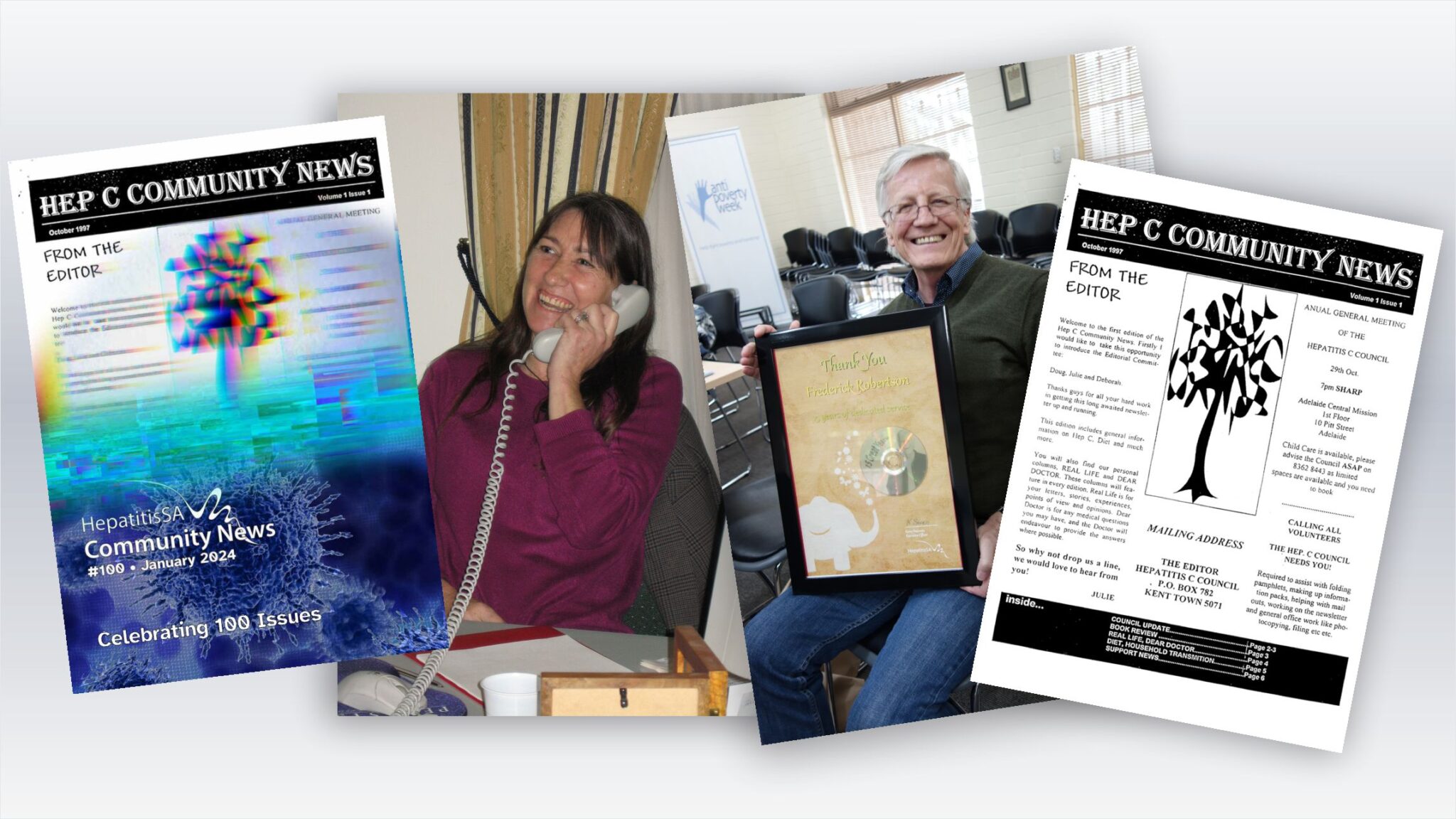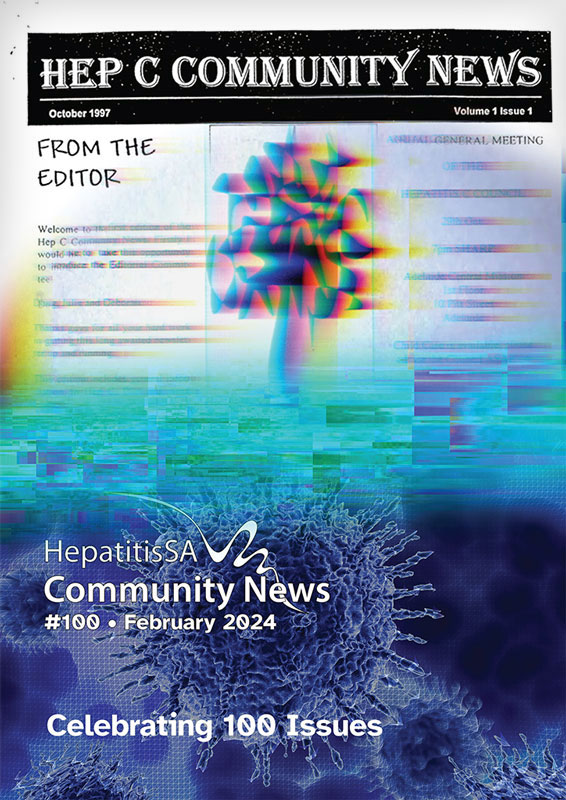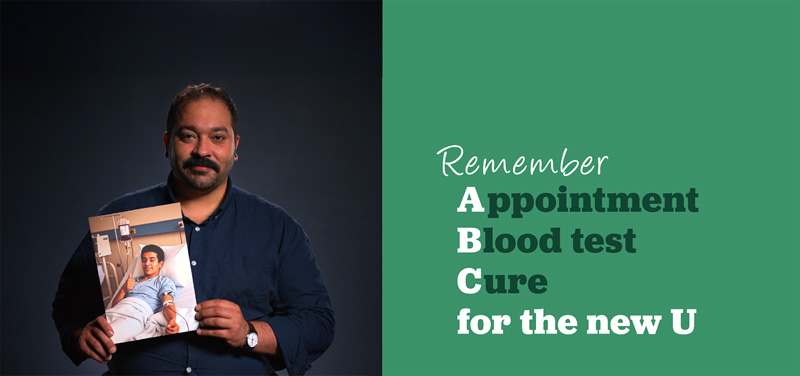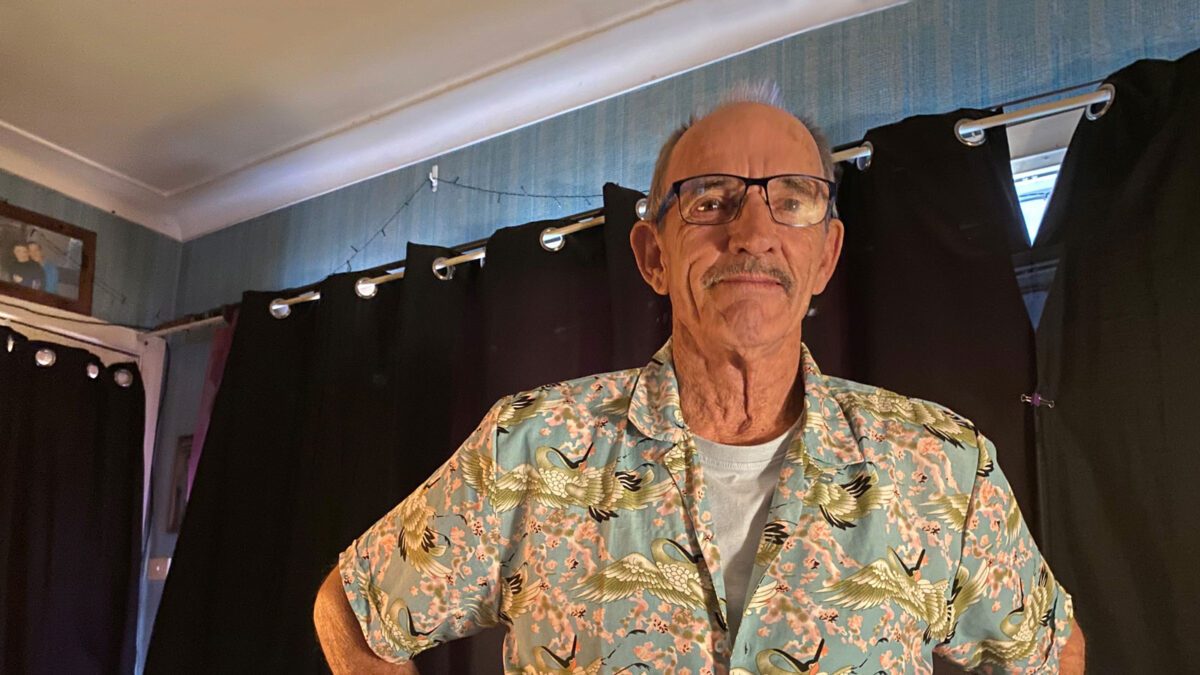Before social media and online chat, there were newsletters. People read them, wrote letters to the editor and contributed essays. That’s when our Community News was born – back in 1997, as a platform for discussion and sharing knowledge – part of a nascent hepatitis C information and support service. Come February 2024, the Community News publishes its 100th issue. In this retrospective, we take a look at how the publication has evolved over the years.
Hepatitis SA veterans, Deborah Warneke-Arnold and Fred Robertson remembered the early, heady days. “We had a tiny room at DASSA on Fourth Avenue, one project officer, Colin, and a one-day-a-week admin person, Julie,” Deborah recalled. “We were getting calls from people wanting more information. We thought, we’ve got all this information from the readings we’re doing, we should share it with a newsletter.”
The Hep C Community News started with an editorial group of five and enthusiasm jumping off its eight pages. (Read issue #1) Sections included Book Review, Real Life, Diet, and a Dear Doctor column with replies from Dr Robina Creaser, and occasionally, other relevant specialists.
The newsletter was rich with news on the Hepatitis C Council SA (HCCSA) and its support group activities, as well as information on transmission, diet, treatments, legal rights and mental health.
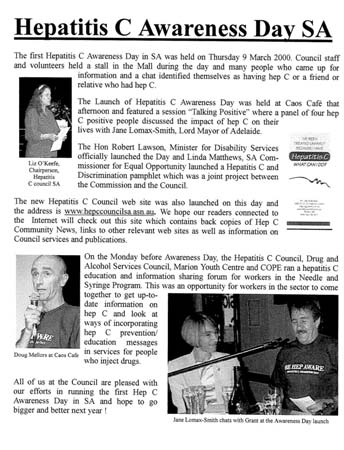
Deborah joined the Council in 1997 and hadn’t looked back since. By mid-1999 she was editor of the Community News. “Doug Mellors [the writer behind Doug’s Desk] taught me how to look up information. I’d go to the Barr Smith library and spend hours there reading up on the latest research. I was so proud of my membership card. I’d be there, putting my head down, reading as much as I could, hoping people would think I’m a student,” she said, laughing.
“I was editor from issues 9 to 20. I learnt all my computer skills from working at the Council, especially on the newsletter – touch-typing and layout with Publisher. It was very much a community learning together.” (More Deborah’s story #16.) Editorial group members working alongside Deborah included Doug Mellors, Sharon Drage, and Fred Robertson, with proofreading support from acting manager Leslie Whiteman. Subsequent issues listed HCCSA Coordinator, Kerry Paterson, as proofreader.
Perhaps the most striking difference between the very early Community News and now, is the lively community engagement…
Deborah remembered key events reported in the magazine. One such highlight was the first Hepatitis C Awareness Day in SA. Issue 12 (Autumn 2000) reported on the Awareness Day launch by the Minister for Disability Services, Robert Lawson. Adelaide Mayor, Jane Lomax-Smith, facilitated a lived experience forum and Equal Opportunity Commissioner, Linda Mathews, launched a pamphlet jointly produced by HCCSA and the Commission.
There was also a pre-Awareness-Day education session run by HCCSA, the Drug and Alcohol Services Council, Marion Youth Centre and COPE; and HCCSA launched its brand new website on that first Awareness Day.
Remarkably, we learn from issue 44 (July 2009), that Dr. Jane Lomax-Smith again launched the Council’s hepatitis C awareness campaign, by then part of the World Hepatitis Day campaign. This time she was doing it as Minister for Mental Health and Substance Abuse, on behalf of Health Minister, John Hill. And coincidentally, HCCSA’s revamped website was also launched that day.
Perhaps the most striking difference between the very early Community News and now, is the lively community engagement: questions to the doctor, angry letters, thank you letters, personal stories and so on. The sort of thing that happen online these days.


Even within the first few years, however, as the information in the magazine got more comprehensive, even though letters to the editor continued to come in from time to time, spontaneous communication declined as the content answered questions before they were asked.
“The changes in the Community News pretty much reflect the changes that had to happen with the Council,” said Fred who was on the editorial and management committees, and had contributed many a book review as well as articles on complementary therapy.
There is no formal archive recording the history of Hepatitis C Council SA – now Hepatitis SA – but the Community News does a pretty good job filling that gap.
“The changes in the organisation were inevitable – it’s a natural growth and progression from an ad hoc community group to a professional NGO that can influence decisions that affect the community.”
He remembered turning up at the Council for information and feeling so welcome that he joined as a member and a volunteer. “It’s different now but it also means things are done with professional staffing, with greater awareness of rules and guidelines which means as an organisation we can do more,” he said.

“The Community News has become more professional in presentation and content, as befits the flagship publication of a peak service organisation,” said Fred. “We lose some spontaneity in the process, but we also gain a lot: more credibility, access to decision-makers, more funding and greater reach.”
There is no formal archive recording the history of Hepatitis C Council SA – now Hepatitis SA – but the Community News does a pretty good job filling that gap.
Its 100 issues to date chart the organisation’s growth from a small group of committed individuals with varying skill levels, to a peak organisation with highly skilled staff providing on-going support and services, reaching more people and having input into state-level decision-making that affects the hepatitis sector and community.
Last updated 8 March 2024
More from:
Enjoyed this article? Subscribe to be notified whenever we publish new stories.
Subscribe for Updates
